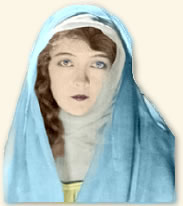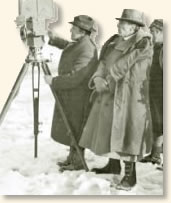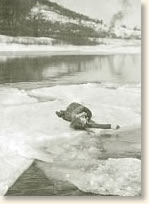|
Making Movies, 1920
Actress Lillian Gish began working in films in 1912
at age eighteen, launching a career that spanned seventy-five years. Her early
years were spent with legendary director D.W. Griffith at the Biograph Studio.
She joined Griffith's troop in New York City, moved to Hollywood with him and
returned
to New York when Griffith setup his studio on Long Island in 1919. By 1920 she
had made over 50 films and established herself as one of Hollywood's earliest stars.
 |
Lillian Gish
|
In 1919, Griffith began production of Way Down East an adaptation of a popular melodramatic stage play. Lillian was cast as the heroine - Anna. The plot revolves around Anna's affair with a playboy who abandons her after learning she is pregnant. The baby dies at birth and Anna escapes to New England where a gracious farmer allows her to live with him and his son (the son, of course, falls in love with Anna). To her horror, Anna discovers her former lover living next door. The dastardly former lover tells the benevolent farmer that Anna has had a child out of wedlock. The farmer's immediate reaction is to cast Anna out of his house - into the midst of a fierce winter blizzard. Anna stumbles through the blinding storm onto the breaking ice of a frozen river only to collapse on an ice floe heading for a deathly waterfall. In a dramatic rescue, the farmer's son leaps from one ice floe to another, reaching and saving Anna just before she plunges over the falls.
The plot is admittedly corny (even Lillian thought so), but Way Down East was a huge success and in 1999, Time Magazine described the film as "the greatest ever made". At any rate, our aim is not film criticism but to gain insight into the making of early Hollywood movies. Lillian provides this insight in her memoirs published years later as she describes the shooting of one this movie's most famous scenes - the howling blizzard rescue. Today, the dramatic rescue on an ice floe during a blizzard would be digitally concocted in a computer while the actors played their roles in a comfortable studio before a "green screen." The two pieces of film would then be combined for the final cut. These technological luxuries did not exist in 1919. Lillian describes the shooting, which took place on Long Island Sound and in Vermont:
"Mr. Griffith intended to shoot all the exterior scenes outdoors, including the blizzard. He wouldn't be satisfied with the fake fury of a studio storm.
For the climax of the movie, where Anna was to be driven out into the blizzard, stumble onto the river's ice, and faint, I tried to get into condition early with exercise, walks in winter gales, and cold baths.
 |
E.W. Griffth directs Way Down East
Billy Bitzer is his cameraman
|
Our house was near the studio, and I was to report for work at any hour that snow started to fall, as we had both day and night scenes to film. It was a late but severe winter; even Long Island Sound was frozen over. I slept with one eye open, waiting for the blizzard. Winter dragged on and was almost over, and still those important scenes hadn't been filmed.
The blizzard finally struck in March. Drifts eight feet high swallowed the studio. The trees on Orienta Point lashed the sky and groaned, as the chains that held them together were stretched taut. Mr. Griffith, Billy [Billy Bitzer - Griffith's cameraman], the staff, and the assistant directors stood with their backs to the gale, bundled up in coats, mufflers, hats, and gloves. To hold the camera upright, three men lay on the ground, gripping the tripod legs. A small fire burned directly beneath the camera to keep the oil from freezing.
Again and again, I struggled through the storm. Once I fainted - and it wasn't in the script. I was hauled to the studio on a sled, thawed out with hot tea, and then brought back to the blizzard, where the others were waiting. We filmed all day and all night, stopping only to eat standing near a bonfire. We never went inside, even for a short warmup. The torture of returning to the cold wasn't worth the temporary warmth. The blizzard never slackened. At one point, the camera froze. There was an excruciating delay as the men, huddled against the wind, tried to get another fire started. At one time my face was caked with a crust of ice and snow, and icicles like little spikes formed on my eyelashes, making it difficult to keep my eyes open.
Above the howling storm, Mr. Griffith shouted: 'Billy, move in! Get that face! That face - get that face!'
'I will,' Billy shouted, 'if the oil doesn't freeze in the camera!' We lost several members of our crew from pneumonia as the result of exposure. Though he worked with his back to the wind whenever possible, Mr. Griffith's face froze. A trained nurse was at his side for the rest of the blizzard and the winter scenes.
The scenes on and around the ice were filmed at White River Junction, Vermont, where the White
 |
Lillian Gish on an ice flow
|
River and the Connecticut flowed side by side. The ice was thick; it had to be either sawed or dynamited, so that there would be floes for each day's filming. The temperature never rose above zero during the three weeks we worked there."
"For the scene in which Anna faints on the ice floe, I thought of a piece of business and suggested it to Mr. Griffith, who agreed it was a fine idea. (I was always having bright ideas and suffering for them.) I suggested that my hand and my hair trail in the water as I lay on the floe that was drifting toward the falls. Mr. Griffith was delighted with the effect.
After a while, my hair froze, and I felt as if my hand were in a flame. To this day, it aches if I am out in the cold for very long. When the sequence was finally finished, I had been on a slab of ice at least twenty times a day for three weeks. In between takes, one of the men would throw a coat around me, and I would warm myself briefly at a fire."
References:
Lillian Gish's account appears in: Gish Lillian, Ann Pinchot, The Movies, Mr. Griffith and Me (1969); Brownlow, Kevin, The Parade's Gone by ... (1983).
How To Cite This Article:
"Making Movies, 1920," EyeWitness to History, www.eyewitnesstohistory.com (2002).
|






